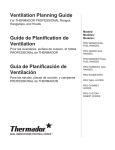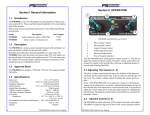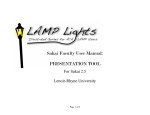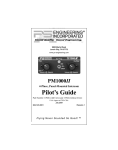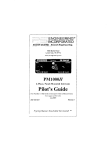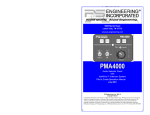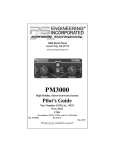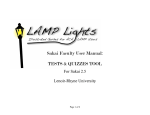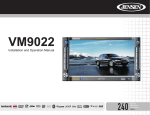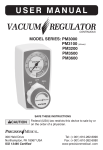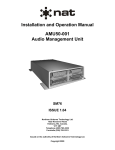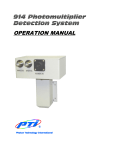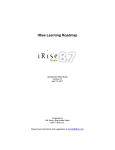Download PM3000 - PS Engineering
Transcript
9800 Martel Road Lenoir City, TN 37772 www.ps-engineering.com PM3000 High-fidelity, Stereo Intercom System Pilot’s Guide PS Engineering, Inc. 2004 © Copyright Notice Copyrighted information in this manual is subject to change without notice. PS Engineering reserves the right to improve or change the products or contents of this manual, without notification of any person or agency. The contents of this pilot’s guide may be downloaded, stored and reprinted for personal use provided that this copyright information is included. Commercial use is strictly prohibited. For further information contact the Publications Manager at PS Engineering, Inc., 9800 Martel Road, Lenoir City, TN 37772. Phone (865) 9889800 202-193-0001 8 PM3000-Pilot Guide & User Manual Part Number 11931, 11932 FAA-TSO C50c Also includes 11933, 11934, non-FAA TSO units 202-193-0001 Revision 2 January 2004 Flying never sounded so good™ PM3000 Pilot Guide & User Manual 1 202-193-0001 Section I General Information Introduction The PM3000 is an FAA-TSO approved, panel mounted, 4- to 6-place highfidelity stereo intercom system (ICS). Please read this manual completely before using the unit to become familiar with all its features. Scope This Pilots Guide contains operational instructions for the following PS Engineering unit : Model PM3000 PM3000 PM3000 PM3000 Description Part Number 4-place intercom system w/pilot iso 11931 6-place intercom system w/crew 11932 4-place w/digital recorder (non-TSO) 11933 6-place w/digital recorder (non-TSO) 11934 NOTE: installation instructions are contained in Installation Manual, part number 200-193-xxxx, available at your authorized PS Engineering Dealer, or www.ps-engineering.com/pm3000.shtml Description The PM3000 is a 4- or 6-place (depending on model), panel-mounted intercom with multiple volume and VOX (voice activated squelch) circuits using unified volume and squelch controls for the pilot, copilot and passengers. With few controls for the pilot to use, the operation of the PM3000 is very straightforward. Yet the unit outperforms its much more complicated competition. Although there is only one volume control knob, when an adjustment is made to the volume control, all output amplifiers are being changed simultaneously. Likewise, when the squelch control knob is adjusted, several VOX circuits are being changed at the same time. Since the system is designed to use modern stereo headsets, it is not necessary to balance the volume and squelch controls at the intercom. The PM3000 has an automatic fail-safe interconnect to the aircraft radios. If power is disrupted to the intercom for any reason, an internal relay will connect the pilot's headset to the aircraft radio allowing continued radio communications. Provision for entertainment input allows the pilot, copilot and passengers the option to listen to music during flight. During intercom or aircraft radio reception, this music will automatically mute to allow communications 202-193-0001 2 PM3000-Pilot Guide & User Manual Section III Warranty and Service In order for the factory warranty to be valid, the installations in a certified aircraft must be accomplished by an FAA-certified avionics shop and authorized PS Engineering dealer. If the unit is being installed by a non-certified individual in an experimental aircraft, a factory-made harness must be used for the warranty to be valid. PS Engineering, Inc. warrants this product to be free from defect in material and workmanship for a period of one year from the date of installation. During this oneyear warranty period, PS Engineering, Inc., at its option, will send a replacement unit at our expense if the unit should be determined to be defective after consultation with a factory technician. This warranty is not transferable. Any implied warranties expire at the expiration date of this warranty. PS Engineering SHALL NOT BE LIABLE FOR INCIDENTAL OR CONSEQUENTIAL DAMAGES. This warranty does not cover a defect that has resulted from improper or unreasonable use or maintenance as determined by us. This warranty is void if there is any attempt to dissemble this product without factory authorization. This warranty gives you specific legal rights, and you may also have other rights, which may vary from state to state. Some states do not allow the exclusion of limitation of incidental or consequential damages, so the above limitation or exclusions may not apply to you. Factory Service The PM3000 is covered by a one-year limited warranty. See warranty information. Contact PS Engineering, Inc. at (865) 988-9800 or through www.ps-engine.com/ support.shtml, before you return the unit. This will allow the service technician to provide any other suggestions for identifying the problem and recommend possible solutions. Units that arrive for repair without a method of payment will be returned via UPS COD. PS Engineering will not be responsible for any item shipped via US Mail. After discussing the problem with the technician and you obtain a Return Authorization Number, ship product to: PS Engineering, Inc. Service Department 9800 Martel Road Lenoir City, TN 37772 (865) 988-9800 FAX (865) 988-6619 www.ps-engineering.com NOTE: PS Engineering will not be responsible for units returned by US Mail, or in other than the original packaging. Units received without either an RMA, or a detailed description of the problem AND a contact telephone number, will be refused. PM3000 Pilot Guide & User Manual 7 202-193-0001 back to the original level after communications have been completed. CREW (11932, 11934 only) (down position): Pilot and copilot positions will hear aircraft radio and music number one. Passengers will only hear other passenger’s intercom, and music number 2. Music number two will not mute during intercom conversation. Music Mute Control Normally, any radio traffic or intercom conversation will mute the music heard in ALL mode, or for the front in CREW. However, when the crew desires uninterrupted music, the PM3000 can be placed in the Karaoke Mode, for singing along. Press the right knob (squelch) once to activate Karaoke mode, so the music will not be muted. Press again to restore the SoftMute™ function without distraction. When the activity ceases, the Soft Mute™ circuit gradually returns the music to the original listening volume. By depressing the “Mute” control (located on the Squelch knob) once, it is possible to have the music remain at a constant level, regardless of any ICS or radio traffic. During various phases of flight, the degree of importance of the aircraft radio will vary. Because the "ISO" mode connects the pilot directly to the aircraft radio, select the "ISO" mode when the pilot must have top priority on radio transmissions. Both pilot and copilot have transmit capabilities over the radio. The PM3000 only allows the voice of the person who presses their PTT to be transmitted over the aircraft radio. If both pilot and copilot press the PTT at the same time, the copilot will override. When either pilot or co-pilot presses PTT, all other microphones are disabled. The pilot can regain priority by switching the unit off. Intercom Recorder System (11933, 11934 only) Approval Basis The Intercom Recording System is a digital recording system allowing automatic storage and playback of aircraft radio traffic. Operating as a continuous loop recorder, (first message received will be the last heard), the recorder has one minute of recording time or up to 16 messages. With its own built in VOX circuit, there are no buttons to press to start recording. The system automatically begins to record the instant the radio becomes active. Aircraft radio audio applied to pilots headset is recorded and only the pilot will hear the playback audio, in one ear. The PM3000, part number 11931 or 11932 is FAA-approved under TSOC50c, and RTCA, Inc. DO-214. Due to the fact that there is no TSO for the recorder function in the 11933 and 11934, these units are not fully TSOapproved. It is the responsibility of the installer to determine the approval basis for these units. Operation Input power: 13.8 - 27.5 Volts DC Current Drain: < 200 mA (Externally fused at 1 Amp) Headphone Impedance: 150-1000 Ω(typical) Audio Distortion: <1.2% @ 50mW into 150 Ω load Aircraft Radio Impedance: 1000 Ω (typical) Mic Frequency Response: ±3 dB, 350 Hz — 6000 Hz Music Frequency Response ±3 dB, 200 Hz – 15kHz Unit weight: 12 Ounces (0.34 kg) Dimensions:1.25" H x 3.00" W x 5.50" D (3.2 x 7.6 x 14.0 cm) Environmental and technical qualifications: RTCA DO-160C/DO-214 Temperature -20º to +55ºC Recording is automatic; there is no action required by the pilot. To play back the last recorded message, simply press the momentary switch associated with the IRS. Each additional press of the button will play the preceding recorded message. You must wait for the message to finish playing before accessing the prior message. To cancel the playback, press and hold the playback button for two seconds. The next time the button is pressed, the next earlier message will be heard. Specifications License Requirements None 202-193-0001 6 PM3000-Pilot Guide & User Manual PM3000 Pilot Guide & User Manual 3 202-193-0001 sic # 2 passenger volume in CREW mode (11932 and 11934) version is a fixed level, and controlled locally by the headphone volume control or music device. Section II Operation Adjusting the Squelch Control (2) PM3000 (11931 & 11933) Adjusting the Volume (1) The PM3000 volume control knob adjusts the loudness of the intercom and music only. The volume control on the PM3000 does not affect the volume level of the aircraft radio. This allows the aircraft radio and intercom volume to be balanced independently. The volume control affects the music level for the pilot and copilot positions. By turning the control clockwise, the audio level will increase. The PM3000 has individual output amplifiers for each headset in the system and provides plenty of audio output power. NOTE: Volume level will not change with the number of headset installed. 2 4 Mu- The green LED in the center indicated green when the unit is turned on, and changes to red during transmit by either the pilot or copilot. The center switch is a mode control that allows the pilot to tailor the intercom function to suit flight conditions. Regardless of configuration, the pilot will always hear the aircraft radio. NOTE: If there is a power failure to the PM3000, or if the power switch is turned off, the copilot will not hear the aircraft radio. Only the pilot is connected directly to the aircraft radio. ISO (Up Position): The pilot is isolated from the intercom and is connected only to the aircraft radios. He will hear the aircraft radio reception (and sidetone during radio transmissions). Copilot and passengers will hear themselves and music but not the aircraft radio traffic. ALL (Middle position): All parties will hear the aircraft radio, intercom, and music. However, during any ICS conversation, the music vol- ume automatically mutes. The music volume increases gradually PM3000 w/ Crew (11932 or 11934) 202-193-0001 Indicator LED (3) Mode Select (4) 3 1 This VOX operated intercom keeps all microphone channels off (silent) while the pilot, copilot or passengers are not speaking. This reduces background noise from the aircraft. Only when someone speaks will their microphone turn on, allowing the audio to pass through the system. Although there is just one squelch control, there are actually three separate squelch threshold circuits. One circuit each for the pilot, copilot, and passengers. Only the microphone actually in use is open, reducing noise in the system. With the engine running, set the squelch control knob by slowly rotating the squelch control knob clockwise until you no longer hear the background noise in the earphones. When the microphone is positioned properly near the lips, normal speech levels should open the channel. When you have stopped talking, there is a delay of about one half second before the channel closes. This prevents squelch closure between words, and helps eliminate choppy intercom conversations. 4 PM3000-Pilot Guide & User Manual PM3000 Pilot Guide & User Manual 5 202-193-0001




